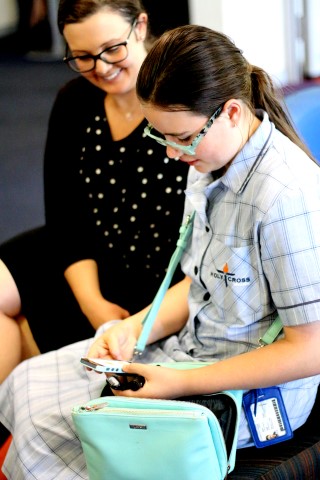 This time last year Keira Reynolds, pictured far right, was in a vastly different place to where she is today.
This time last year Keira Reynolds, pictured far right, was in a vastly different place to where she is today.
Back then, the Year 6 student was coming to grips with a new type 1 diabetes diagnosis and finishing primary school, uncertain about what lay ahead at high school.
Fast forward to today and Keira has just finished Year 7 at Holy Cross College in Ellenbrook and has had a fantastic year — socially, academically and health wise.
“As Keira was halfway through Year 6 when she was diagnosed, we were really worried what would happen when she started high school,” Keira’s mum Olivia Reynolds said.
“We were all a bit anxious about her going from being one of the big kids in a small school to a new school on much bigger premises with lots of teachers.”
Mrs Reynolds said the pair met with Holy Cross College school nurse Grace Bradshaw, pictured above with Keira, to talk about Keira’s diabetes management plan towards the end of last year.
She said it was comforting to know the college already had four students with diabetes and were familiar with the chronic disease and its management.
“Keira uses a continuous glucose monitor which allows Grace and I to remotely see how her blood glucose levels are going,” she said.
“If there’s an issue and Keira hasn’t done anything about it, we will receive a notification and can text her to do a correction.
“I’m a lot more relaxed knowing that at any time there are extra sets of eyes watching Keira’s blood glucose levels.”
Miss Bradshaw said the key to a good transition was to establish a good rapport between the new school, parents and student.
“Parents need to know that their child is in safe hands and that you are there at any time to discuss their child’s management plan or any issues,” she said.
“Part of my job is ensuring that the teachers of students with diabetes know to be on the lookout for signs of a student going low or high and how to handle it.”
Miss Bradshaw said Keira had come a long way over the course of the year.
“Keira is doing really well. It has a lot to do with her accepting her condition and becoming older and more independent with her diabetes management,” she said.
Arthur Wright, a diabetes liaison teacher from the School of Special Educational Needs: Medical and Mental Health (SSEN: MMH), said transitioning from primary school to secondary school presented a lot of challenges to students, regardless of whether they had diabetes.
“When you add the overlays of diabetes and adolescence, things become much more complex because students are trying to manage a chronic medical condition while trying to ‘fit in’ with their peers in a very unfamiliar environment,” Mr Wright said.
Mr Wright advised parents to make contact with the Year 7 coordinator to put their child’s diabetes management plan in place before the start of the new school year.
“Diabetes management plans form a clear, agreed plan of action so that both family and school have a consistent expectation of how diabetes will be managed in school,” he said.
Professor Liz Davis, co-director of the Children’s Diabetes Centre at The Kids Research Institute Australia, said diabetes action plans needed to be renewed at the start of each new school year or if there was a change in circumstances such as a student moving from insulin injections to pump therapy.
She said the SSEN: MMH provided a valuable communication link between schools and Perth Children’s Hospital Diabetes Service and was available to liaise with schools on behalf of parents if needed.
The Managing Diabetes in Schools: Best Practice Guidelines resource contains lots of helpful information and hyperlinks. View it here.
TOP TIPS
- It is important the secondary school receives a copy your child’s diabetes management plan as soon as possible. Doing so will ensure staff can easily access health care plans and professional learning in preparation for the new school year.
- Meet with key secondary school staff to discuss your child’s management plan and things such as diabetes equipment storage, where injections will be given, whether staff will have professional diabetes learning, and which staff will be trained.
Source: School of Special Educational Needs: Medical and Mental Health
